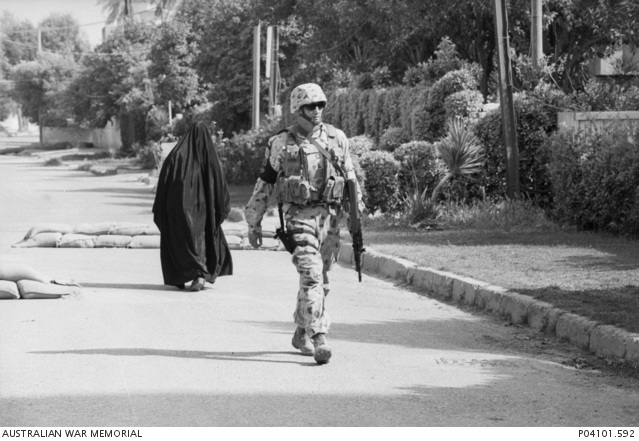Iraq, 2003–09
On 20 March 2003, a combined force of American, British and Australian troops under US leadership invaded Iraq in what was termed "the Second Gulf War". Their object was to locate and destroy suspected weapons of mass destruction.
Small but highly effective Australian army, air force, and navy elements assisted the operation. Within three weeks coalition forces had seized Baghdad and the corrupt and brutal dictatorship of Saddam Hussein was overthrown. However, no weapons of mass destruction were found.
The coalition’s victory was followed by a difficult "nation building" and counter-insurgency campaign to prevent Iraq sliding into civil war. In July 2003 an Australian army training team began to train Iraqi soldiers in Iraq and in April 2005 the army deployed a task group to southern Iraq to protect a Japanese engineer construction unit.
Iraq: Warrant Officer Lionel Orreal from the 1st Military Police Battalion passes an Iraqi woman wearing the traditional burka while on patrol outside the former Australian Embassy residence, Baghdad.
By 2006, approximately 1,400 Australian soldiers remained engaged in reconstruction and rehabilitation work in Iraq together with American and other coalition forces. In mid-2008 Australia began to reduce its forces with the withdrawal of approximately 500 troops, leaving almost 1,000 Australian soldiers in Iraq. Australian combat troops ceased their operational role in Iraq on 31 July 2009.
By May 2011 all non-US coalition forces had withdrawn from Iraq and the US military withdraw all forces on 18 December 2011, thus ending the Iraq War.
Two Australian service personnel died in the conflict in Iraq between 16 July 2003 and 31 July 2009.
Sources and further reading:
Department of Defence, The war in Iraq: ADF operations in the Middle East in 2003, Canberra, Department of Defence, 2004
Marcus Fielding, Red Zone Baghdad: my war in Iraq, Sydney, Big Sky, 2011
Jim Molan, Running the war in Iraq: an Australian general, 300,000 troops, the bloodiest conflict of our time, Sydney, HarperCollins, 2008
John Mortimer and David Stevens (eds), Presence, power projection and sea control: the RAN in the Gulf, 1990–2009, Canberra, Sea Power Centre – Australia, 2009
